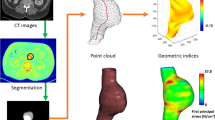Abstract
Abdominal aortic aneurysm (AAA) growth is correlated with rupture risk, but predicting either AAA growth or rupture remains challenging. Global aneurysm geometric properties have been linked with elevated peak AAA wall stress when using finite element analysis (FEA) and may predict AAA growth. We used a machine learning model to evaluate whether image-derived geometric parameters, calculated both globally and locally over the surface of the aneurysm can predict local AAA wall growth, avoiding material property assumptions used in FEA. Sequential CTAs one year apart were collected from 10 patients with AAAs. The luminal and aortic wall were segmented in patient’s baseline CTA. In order to calculate local geometric properties, each baseline AAA was divided into 64 regions to define regional geometric aneurysm characteristics from vertices in that region, and into 1,500 sub-regions in order to define sub-regional geometric characteristics. The global and local (regional and sub-regional) aortic geometric properties were all derived from the images and determined from the aortic segmentation and surface mesh. Local AAA growth between CTAs was determined at the sub-regional level using deformable image registration and was the outcome variable for the model. Patient demographics, as well as the global and local geometric aneurysm properties were used to predict local AAA growth using an eXtreme gradient boosted regression tree using a performance metric of root-mean-square error (RMSE) with 80/20 training to testing split. Mean relative error in predicting maximum AAA growth was 10.5% in the testing set. The most impactful predictors were AAA volume, regional maximum diameter, regional maximum Gaussian surface curvature, regional median aneurysm thickness, and patient age. Removal of local geometric properties from the model increased RMSE from 0.5 to 1.1 and decreased model performance by likelihood test (P = 0.01). Utilizing both global and local aneurysm geometric characteristics better predicts local aortic wall growth in AAAs, avoiding assumptions required using FEA.
Access this chapter
Tax calculation will be finalised at checkout
Purchases are for personal use only
Similar content being viewed by others
References
Beckman, J.A., Creager, M.A., Dzau, V.J., Loscalzo, J.: Aortic aneurysms: pathophysiology, epidemiology and prognosis. In: Vascular Medicine. Saunders Elsevier Inc, Philadelphia, PA (2006)
Schermerhorn, M.L., et al.: Changes in abdominal aortic aneurysm rupture and short-term mortality, 1995–2008: a retrospective observational study. Ann. Surg. 256, 651–658 (2012)
Chaikof, E.L., et al.: The society for vascular surgery practice guidelines on the care of patients with an abdominal aortic aneurysm. J. Vasc. Surg. 67, 2-77.e2 (2018)
Nicholls, S.C., Gardner, J.B., Meissner, M.H., Johansen, H.K.: Rupture in small abdominal aortic aneurysms. J. Vasc. Surg. 28, 884–888 (1998)
Hong, H., Yang, Y., Liu, B., Cai, W.: Imaging of abdominal aortic aneurysm: the present and the future. Curr. Vasc. Pharmacol. 8, 808–819 (2010)
Parkinson, F., Ferguson, S., Lewis, P., Williams, I.M., Twine, C.P.: Rupture rates of untreated large abdominal aortic aneurysms in patients unfit for elective repair. J. Vasc. Surg. 61, 1606–1612 (2015)
Shang, E.K., et al.: Peak wall stress predicts expansion rate in descending thoracic aortic aneurysms. Ann. Thorac. Surg. 95, 593–598 (2013)
Leemans, E.L., Willems, T.P., van der Laan, M.J., Slump, C.H., Zeebregts, C.J.: Biomechanical indices for rupture risk estimation in abdominal aortic aneurysms. J. Endovasc. Ther. 24, 254–261 (2017)
Urrutia, J., Roy, A., Raut, S.S., Antón, R., Muluk, S.C., Finol, E.A.: Geometric surrogates of abdominal aortic aneurysm wall mechanics. Med. Eng. Phys. 59, 43–49 (2018)
Hua, J., Mower, W.R.: Simple geometric characteristics fail to reliably predict abdominal aortic aneurysm wall stresses. J. Vasc. Surg. 34, 308–315 (2001)
Lee, R., et al.: Applied machine learning for the prediction of growth of abdominal aortic aneurysm in humans. EJVES Short Rep. 39, 24–28 (2018)
Yushkevich, P.A., et al.: User-guided 3D active contour segmentation of anatomical structures: significantly improved efficiency and reliability. Neuroimage 31, 1116–1128 (2006)
Yushkevich, P.A., Pluta, J., Wang, H., Wisse, L.E.M., Das, S., Wolk, D.: IC-P-174: fast automatic segmentation of hippocampal subfields and medial temporal lobe subregions in 3 tesla and 7 tesla T2-weighted MRI. Alzheimer’s Dement. 12, P126–P127 (2016)
Eddinger, K.C., Stoecker, J.B., Pouch, A.M., Vrudhula, A., Jackson, B.M.: Local aortic wall expansion measured with automated image analysis. J. Vasc. Surg. 72, e262 (2020)
Soto, B., Vila, L., Dilmé, J.F., Escudero, J.R., Bellmunt, S., Camacho, M.: Increased peak wall stress, but not maximum diameter, is associated with symptomatic abdominal aortic aneurysm. Eur. J. Vasc. Endovasc. Surg. 54, 706–711 (2017)
Shang, E.K., et al.: Impact of wall thickness and saccular geometry on the computational wall stress of descending thoracic aortic aneurysms. Circulation 128, S157–S162 (2013)
Haller, S.J., Azarbal, A.F., Rugonyi, S.: Predictors of abdominal aortic aneurysm risks. Bioengineering (Basel) 7, 79 (2020)
Jalalahmadi, G., Helguera, M., Linte, C.A.: A machine leaning approach for abdominal aortic aneurysm severity assessment using geometric, biomechanical, and patient-specific historical clinical features. In: Proceedings of SPIE International Society for Optical Engineering, vol. 11317 (2020)
Hirata, K., et al.: Machine learning to predict the rapid growth of small abdominal aortic aneurysm. J. Comput. Assist. Tomogr. 44, 37–42 (2020)
Li, A.E., et al.: Using MRI to assess aortic wall thickness in the multiethnic study of atherosclerosis: distribution by race, sex, and age. Am. J. Roentgenol. 182, 593–597 (2004)
Author information
Authors and Affiliations
Corresponding author
Editor information
Editors and Affiliations
Rights and permissions
Copyright information
© 2021 Springer Nature Switzerland AG
About this paper
Cite this paper
Stoecker, J.B., Eddinger, K.C., Pouch, A.M., Jackson, B.M. (2021). Image-Derived Geometric Characteristics Predict Abdominal Aortic Aneurysm Growth in a Machine Learning Model. In: Ennis, D.B., Perotti, L.E., Wang, V.Y. (eds) Functional Imaging and Modeling of the Heart. FIMH 2021. Lecture Notes in Computer Science(), vol 12738. Springer, Cham. https://doi.org/10.1007/978-3-030-78710-3_4
Download citation
DOI: https://doi.org/10.1007/978-3-030-78710-3_4
Published:
Publisher Name: Springer, Cham
Print ISBN: 978-3-030-78709-7
Online ISBN: 978-3-030-78710-3
eBook Packages: Computer ScienceComputer Science (R0)




